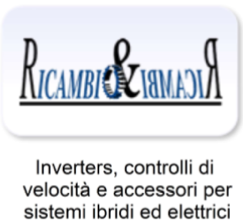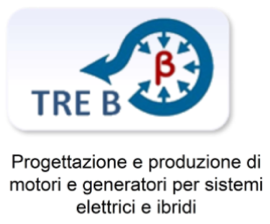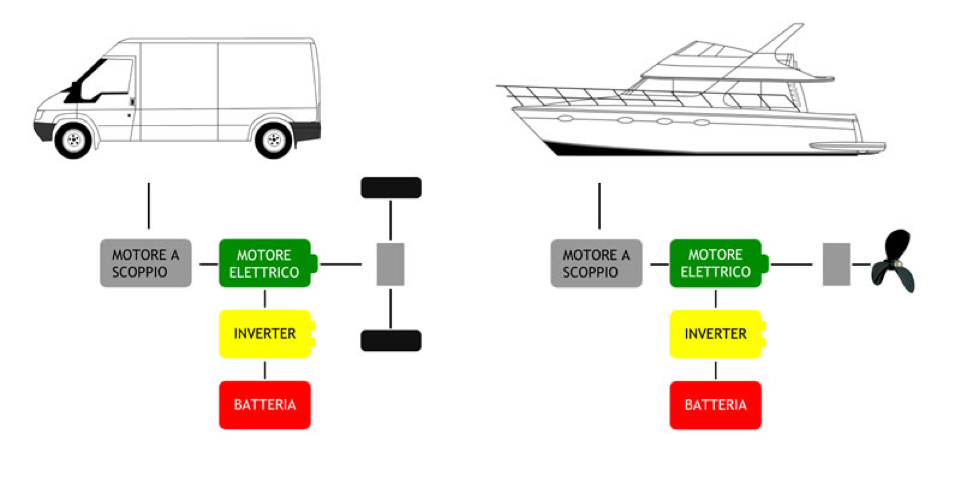HYBRID VAN
The sector of hybrid vehicles, or bimodal drive vehicles (electric-endothermic engine combination) is, to date, the most effective solution for the reduction of pollution in urban centers as it allows to exceed the limits of use of vehicles with electric traction only (low autonomy, long charging times).
The vehicle market had been growing steadily in recent years and reached 740,000 units globally in 2009. Within this market, the commercial vehicle sector, which was also growing strongly, was characterized by the presence of numerous after-market converters that hybridized the production vehicles on the market. The large manufacturers, in fact, were not interested as the sales numbers were too small for their sales targets. For the hybridization of vehicles, the transformers turned to a series of component manufacturers on the market (electric motors, inverters, batteries, pumps, BMS, etc.) whose offer was rather fragmented and characterized by the absence of a complete and comprehensive offer (hybridization kits). In this situation, therefore, they were faced with different interlocutors that provided only part of the kit, often with problems of poor compatibility with components of other manufacturers. In addition to this, since this is a market in the development phase, the margins for improvement in performance, obtainable with research and innovation but also with the optimization of components, were considerable. At the same time, further interesting development opportunities were present in the nautical sector for the hybridization of boats both for private use and for public transport.
For this reason, a partnership has been set up between companies specialising in the sector which wish to cooperate, in the form of a network contract, for the development and supply of complete and optimised kits for hybridisation of commercial road vehicles, industrial vehicles and small craft; the service was then completed with technical assistance in the transformation phase and in the certification and approval practices. Moreover, the partners were also able, on request, to supply themselves customised hybrid vehicles, for example for the construction of corporate fleets, public transport vehicles, commercial fleets.
This project was carried out in aggregate form by the network called “HYBRID-VAN” composed of partners entirely Lombard that are:




In order to achieve the strategic objectives, the companies had defined the following network programme:
- Design and development of the kit, consisting in part of components already in the catalog of individual partners, and in part was required the design of new components (eg. Inverter with relative control software, high performance motors) for performance improvement and kit optimization);
- Joint R&D activities for continuous kit improvement;
- Technical assistance and consultancy in the development of hybrid vehicles;
- Joint promotional and marketing activities through a network brand: in this regard VEB has made available to the network its own brand HYBRID-VAN;
- Further promotional activities for strengthening the network and penetration in new foreign markets of interest.
The Network could also participate in the procedures of Community, State, regional and local public administrations for access to incentives to develop projects aimed at raising the competitive level of its members, the procedures inherent to access to credit or/and those inherent to the development of the business system in the processes of internationalization and innovation provided for by the law.
In order to measure the progress towards the network’s objectives, each participant agreed on the following modalities:
- Increase in the turnover of member undertakings;
- Increase in the number of customers of member companies.
The aim of the project is to create a powertrain for the hybridisation of commercial vehicles and vessels. The idea is to design and build prototypes and components for hybridization or electrification of road and naval vehicles with the objectives of:
- Reduce the fuel consumption;
- Ensure access to every urban centre and marine park or protected area;
- Have a high attention to the environment;
Pure electric naval vehicle, for those who want to make an electric battery-powered vehicle.

Long-distance road vehicle with the possibility of recharging the batteries while driving.

Use of powertrain as a KERS function, hybridization only as a fuel saver.

IT HAS BEEN DEVELOPED THANKS TO THE SUPPORT
operational, organizational and financial of Eng. Fabio Manenti and Demix International Consulting
They have contributed both to obtaining public funding for over €300,000.00 through the programs: Announcement of Ergon and Vouchers for Innovation by Lombardy Region and LET – Lombardy Export Trade of Unioncamere Lombardy, that the international commercial marketing development of the project.
